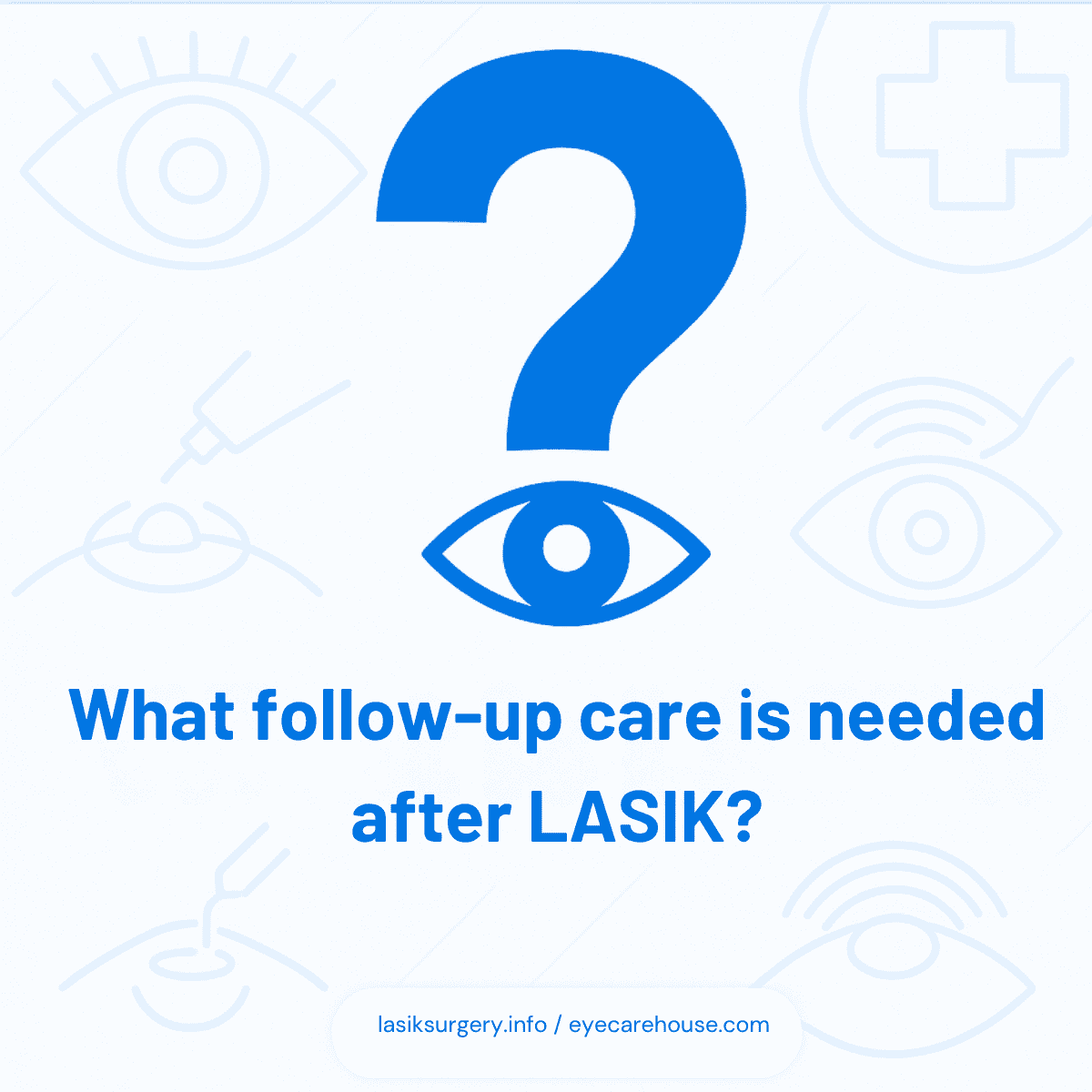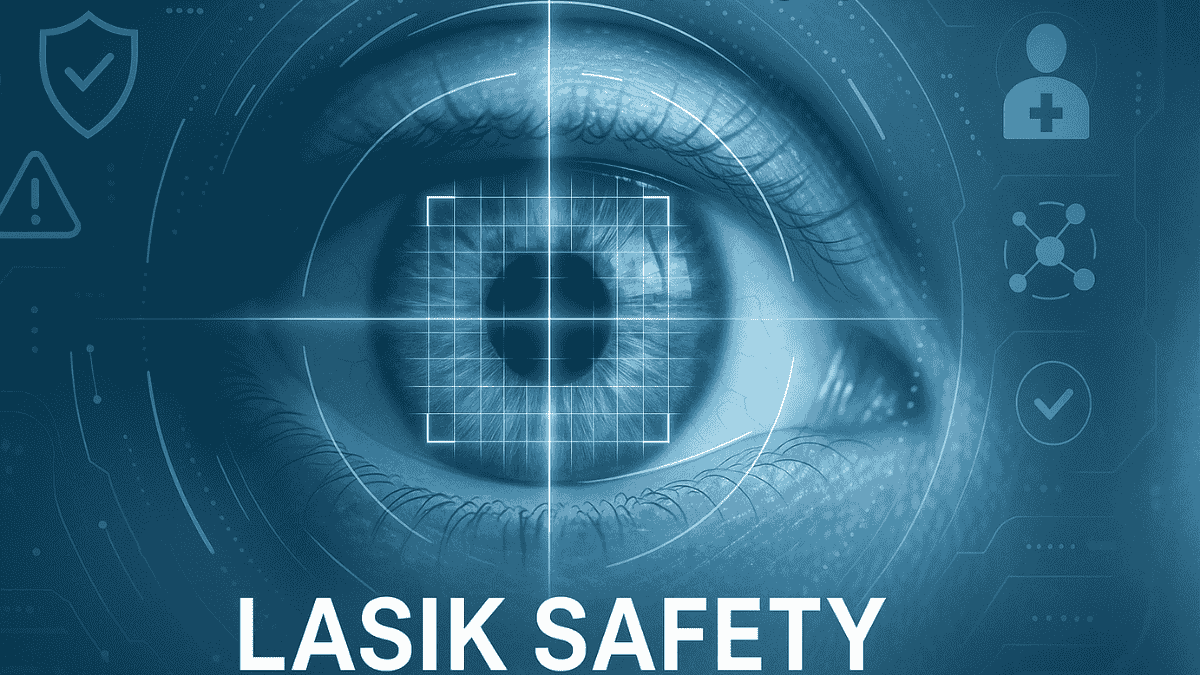
The big question on your mind, the one that makes your palms sweat a little: can you go blind from LASIK? It is a scary thought, and understandable. Thinking about anything happening to your vision is unsettling, and many people experience a fear tied to the prospect of surgery. Many people wonder if the very correction surgery meant to improve sight could actually cause something as devastating as blindness, a significant LASIK vision loss. So, let’s talk about it; we will look at the facts surrounding if can you go blind from LASIK.
Table of Contents
What Does “Going Blind from LASIK” Actually Mean?
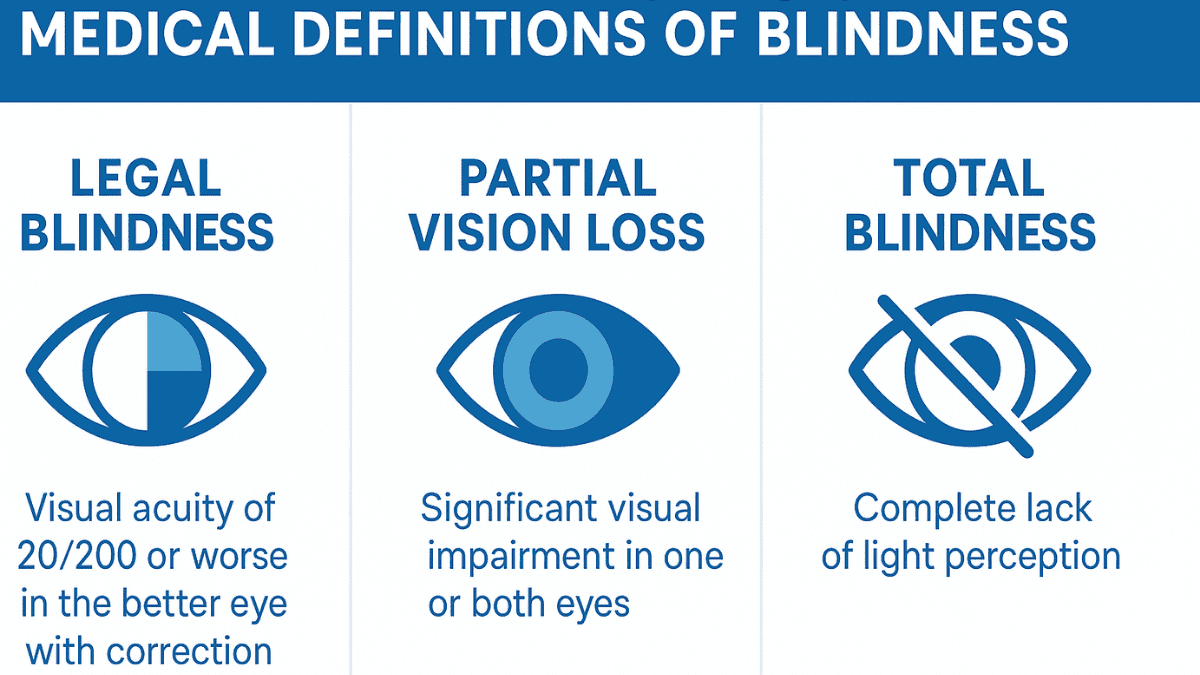
When people ask about “going blind,” it is important to understand what that truly means. Are we talking about a total loss of light perception, or perhaps significant vision loss that is not correctable with glasses or contacts? The term “blindness” itself has specific medical definitions, and understanding them helps clarify the discussion about potential LASIK outcomes.
Often, legal blindness means vision that cannot be corrected to better than 20/200 in the better eye, even with corrective lenses. For LASIK, any reports of serious vision loss are extremely rare. Most issues people hear about are actually treatable complications or side effects that eventually fade over a period, perhaps a month time for minor issues.
These temporary disturbances are not the same as permanent, total blindness. Understanding this difference is fundamental when we discuss potential LASIK surgery risk. It helps to separate temporary visual disturbances, like initial blurry vision, from permanent vision damage; permanent blindness is a very different, and much more serious, outcome.
Can You Go Blind From LASIK? Understanding Safety and Actual Risks
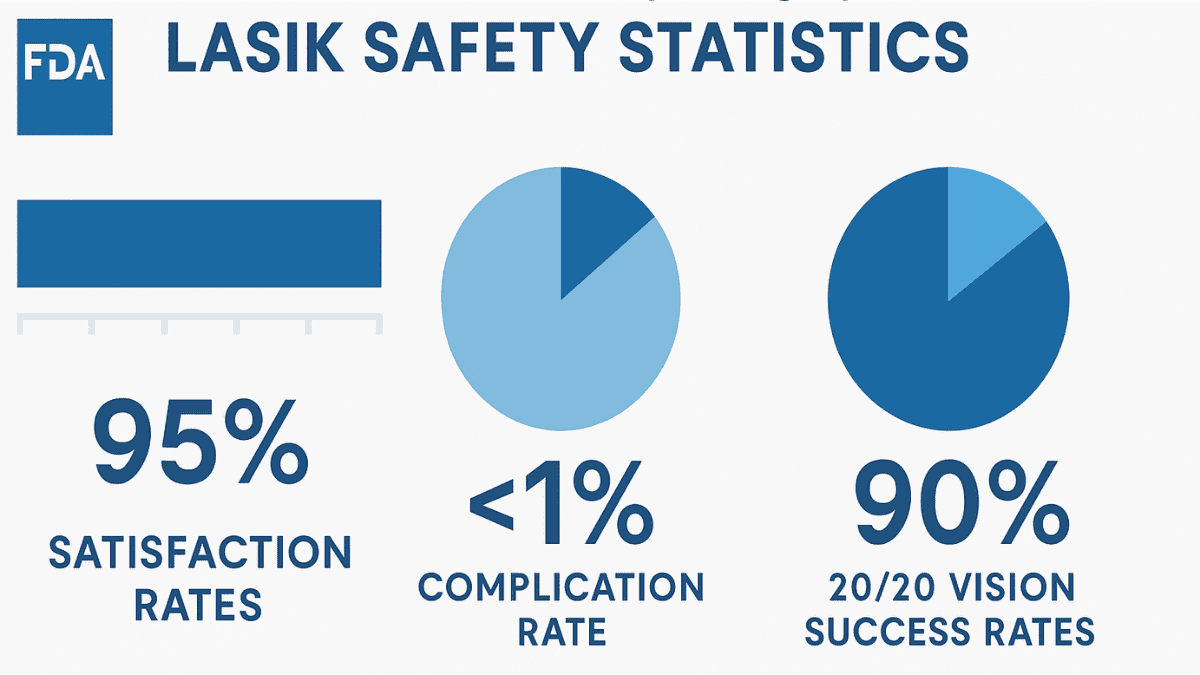
LASIK eye surgery has been a popular vision correction option for decades now, offering hope to millions with vision problems. Millions of LASIK procedures have been successfully performed all over the world. Scientists and eye doctors have studied its safety and effectiveness extensively for many years, examining the surgery risk associated with this type of elective surgical procedures today.
You want to know, is it safe? And what about the big fear, the fear of blindness, specifically can you go blind from LASIK? Organizations like the U.S. Food and Drug Administration (FDA) closely monitor medical devices and procedures, including those used in advanced LASIK. The FDA reviews data from FDA clinical trials before approving LASIK lasers and associated technologies.
They also continue to collect information on patient outcomes and reported LASIK complications after approval. This ongoing vigilance helps them keep an eye on safety over time for all correction procedures. The overall consensus from numerous studies published on platforms like PubMed is that LASIK is a safe procedure for suitable candidates.
Patient satisfaction rates are generally very high, with many people experiencing a life-changing improvement in their LASIK vision. Of course, like any surgery, it is not entirely without risk, no matter how exceedingly small that risk might be. Experienced providers minimize risk through careful patient selection and precise surgical technique.
Serious complications that could lead to significant LASIK vision loss are very uncommon. The technology used in performing LASIK has also advanced a lot. Modern lasers and diagnostic tools have made the LASIK procedure more precise and predictable than ever before, which contributes to its strong safety profile and helps minimize risk of adverse events.
LASIK Complication Rates vs. Blindness Incidence
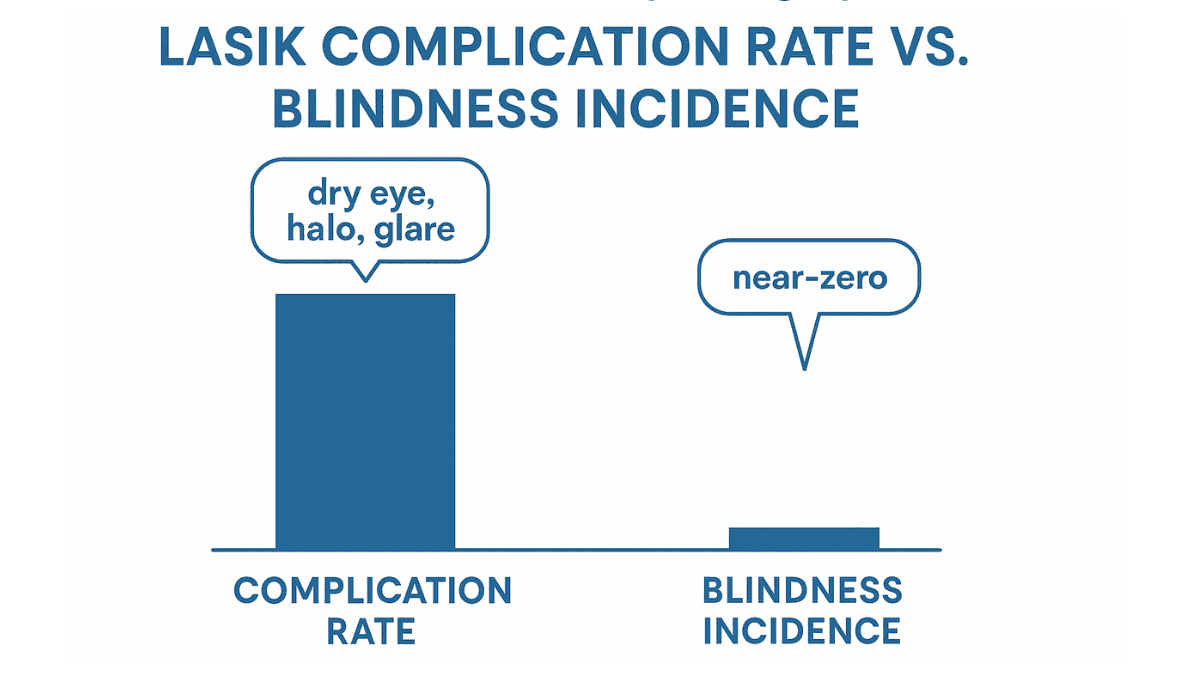
Let’s talk numbers, because they help paint a clearer picture of the real risks involved when considering LASIK eye surgery. The general LASIK complication rate is low. Most complications are minor and temporary, not leading to permanent vision problems.
For example, dry eyes are a common side effect. Many patients experience this for a period after surgery, but it usually gets better with eye drops or over time, often within a few weeks to a month. Glare, halos around lights, or difficulty with night vision are other reported issues; these too often improve as your eyes heal from the LASIK eye procedure.
The American Academy of Ophthalmology (AAO) states that significant, vision-threatening complications are rare. They report that more than 90% of LASIK patients achieve vision between 20/20 and 20/40 without glasses or contact lenses. The American Refractive Surgery Council also provides valuable information and statistics regarding the safety of vision correction procedures.
So, what about the actual chances of going blind from LASIK? This is the core worry, the fear of blindness that troubles prospective patients. Documented cases of total blindness, meaning a complete loss of light perception, directly and solely caused by LASIK are incredibly, exceedingly small. Modern studies and surveillance show this surgery risk to be exceptionally low, practically negligible, when the procedure is done correctly by experienced providers on a well-screened patient.
Most “LASIK failure rate” discussions focus on not achieving the desired vision, such as issues with undercorrection or overcorrection, not blindness. More serious, yet still rare, LASIK complications might include infections or problems with the corneal flap created during surgery. Even these issues, if they happen, are often treatable with medication or more procedures, and experienced LASIK surgeons are adept at managing them.
They do not typically lead to irreversible blindness, especially if caught and managed early with diligent postoperative care. The distinction between a complication and blindness is vital here; while complications are a surgery risk, permanent blindness from performing LASIK is almost unheard of. Providers minimize these risks through extensive pre-operative checks and advanced surgical techniques.
Related Article
LASIK Eye Surgery: Common Risks ExplainedReal-World Cases: Has Anyone Gone Blind from LASIK?
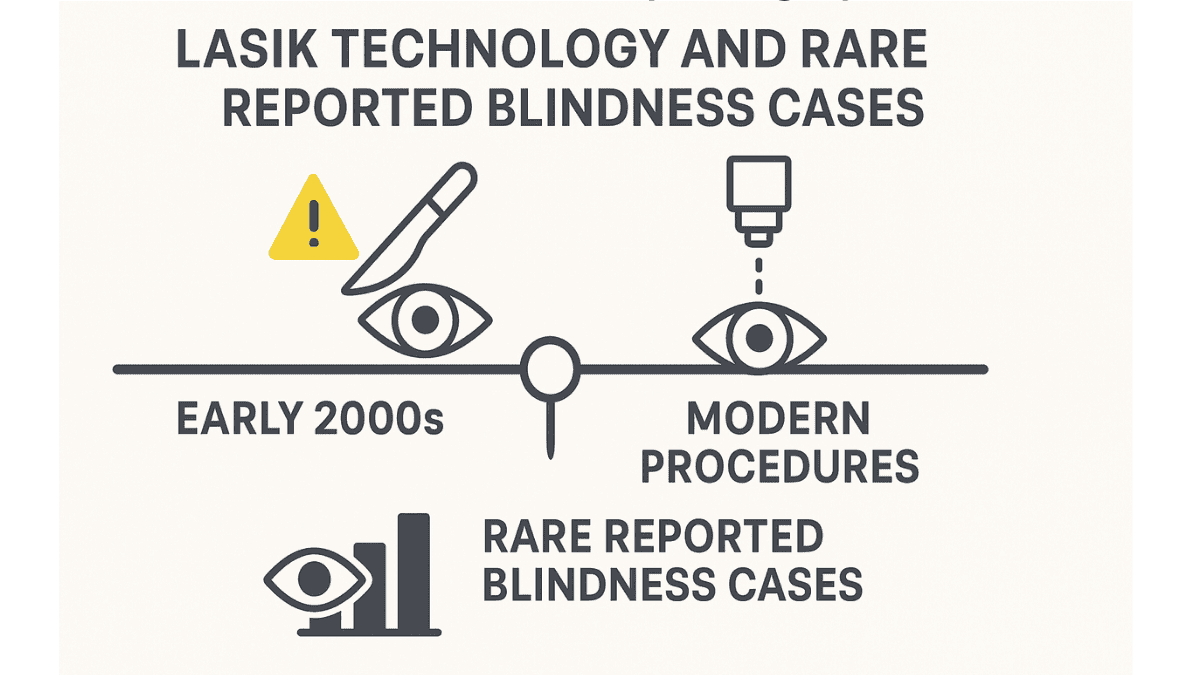
This is a question many people type into search engines: “has anyone gone blind from LASIK?” It is a fair question when you are considering any LASIK surgery for your eyes. Finding credible, confirmed reports of total blindness as a direct result of LASIK surgery itself is exceedingly difficult, meaning it is an exceptionally rare event.
This means scenarios where LASIK was the sole cause, performed correctly on a suitable candidate using modern standards and advanced LASIK techniques, are almost non-existent. Most horror stories you might find online often lack complete medical context or documentation. Sometimes these stories involve very old technology or procedures performed on individuals who might not have been ideal candidates to begin with, thereby increasing their surgery risk.
Some might even confuse LASIK with other types of eye surgeries or underlying conditions that cause vision problems. It is true that any surgery carries some risk. Severe infections, if left untreated or if they are particularly aggressive, could theoretically lead to significant vision loss.
Inflammation or issues with corneal healing, in very rare circumstances, could also impact LASIK vision severely. However, these scenarios are far from the norm and are not what people typically experience. Modern LASIK, a sophisticated form of correction surgery, is designed with multiple safeguards to minimize such extreme outcomes. Always seek information from reliable medical sources and discuss your concerns with a qualified LASIK surgeon to alleviate any fear blind thoughts.
Related Article
LASIK Eye Surgery Success StatisticsWhat Increases the Risk of Complications?
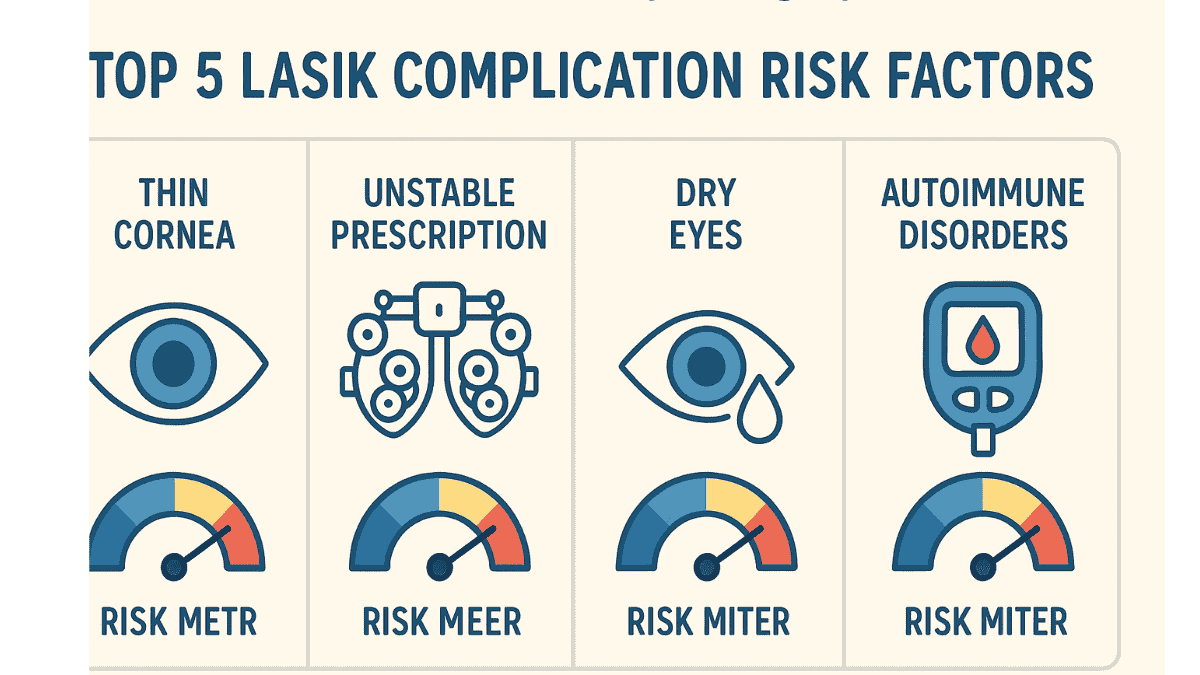
Certain factors can unfortunately increase the surgery risk of complications from LASIK eye surgery. This is why not everyone is a good candidate for the surgery, and a thorough consultation process is essential. Your eye doctor, preferably an experienced LASIK surgeon, will perform a very thorough screening process to identify any potential LASIK issues.
This screening is the most important step to help lower any potential risks associated with the LASIK procedure. Here are some things that might make LASIK less suitable or riskier for you, potentially leading to unwanted vision problems:
Very thin corneas: LASIK involves creating a flap and reshaping the cornea. If your cornea is too thin to start with, the procedure could weaken it, leading to a condition called ectasia which can cause progressive blurry vision.
- Unstable vision prescription: If your glasses or contact lens prescription has changed recently, it is usually best to wait. Performing LASIK on an unstable prescription means the results will likely not be stable either.
- Certain eye diseases: Conditions like advanced glaucoma, keratoconus (a progressive thinning and bulging of the cornea), severe dry eye syndrome, or active eye infections can rule out LASIK. These conditions can interfere with healing or be worsened by the LASIK procedure.
- Autoimmune disorders: Diseases like lupus or rheumatoid arthritis can sometimes affect healing. They may slow down the recovery process or increase the risk of inflammatory responses or severe dry eye after LASIK eye surgery.
- Age and overall health: Some health conditions, like uncontrolled diabetes, can also impact healing and the body’s ability to recover from surgical procedures today.
- The pre-operative consultation process is absolutely critical. During this appointment, your LASIK surgeon will examine your eyes in detail. They will measure your corneal thickness, map your corneal shape using advanced diagnostics, and check for any underlying conditions that could elevate your surgery risk.
Being completely honest about your medical history and any eye symptoms you have is so important. This helps your doctor determine if LASIK is a safe and appropriate choice for you. If you are not a good candidate, pursuing the surgery could increase your chance of having issues and not achieving the desired LASIK vision. (You can learn more about suitability by reading about Are You a Good Candidate for LASIK?).
Choosing a reputable clinic with experienced providers also plays a big part in managing risks. An experienced LASIK surgeon is better equipped to identify potential LASIK concerns and use the technology correctly, further helping to minimize risk. They can also discuss aspects like the lasik cost and what is included in postoperative care.
What About Those “LASIK Gone Wrong” Stories?
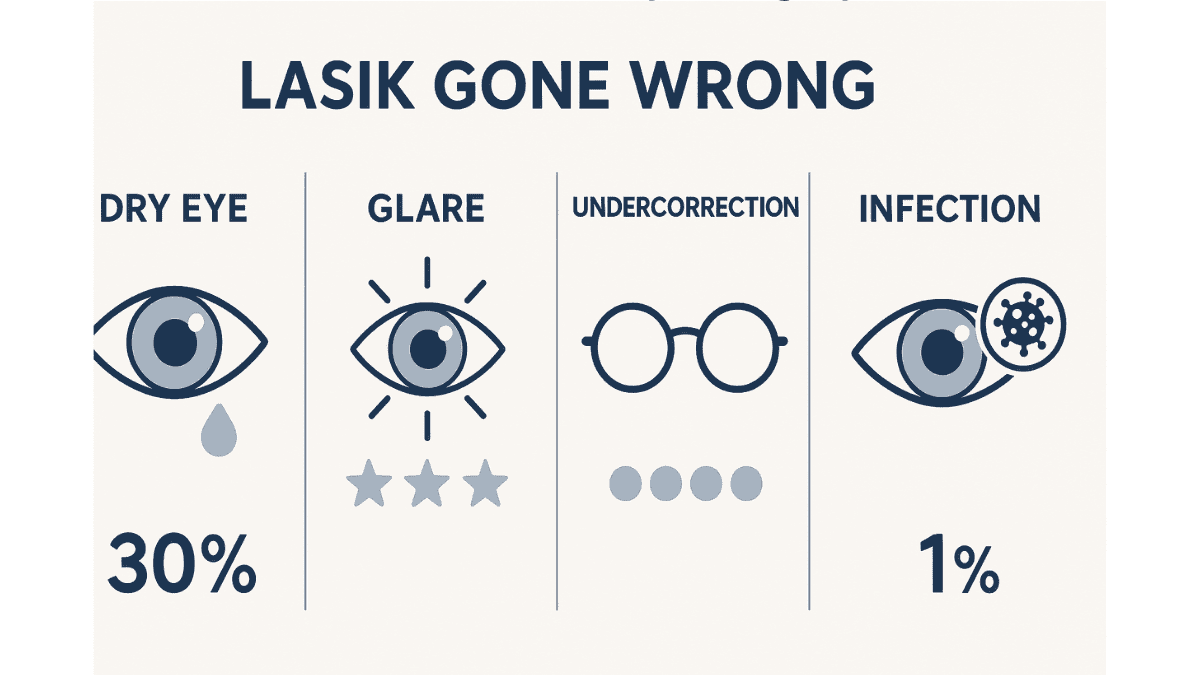
You have probably come across some scary stories online, perhaps titled “laser eye surgery gone wrong.” These can be really alarming to read when you are thinking about surgery for your own eyes and have a natural fear of blindness. But it is important to understand what these stories usually mean; more often than not, they refer to dissatisfaction with the visual outcome or persistent side effects rather than actual blindness or severe LASIK vision loss.
For example, “LASIK gone wrong” might mean someone experienced ongoing severe dry eye. Or they might have noticeable glare, halos, or starbursts around lights, especially at night, causing blurry vision in certain conditions. Sometimes, it might mean the surgery did not fully correct their vision (an undercorrection) or it corrected it too much (an overcorrection), necessitating further correction surgery or continued use of glasses.
These individuals might still need glasses or contacts for certain activities, or they might need an enhancement procedure. While these outcomes are not ideal and can be frustrating, they are very different from suffering permanent blindness. One specific, though uncommon, complication is epithelial ingrowth, where epithelial cells grow under the corneal flap after the LASIK procedure. While this can cause blurry vision and require treatment, it does not typically lead to blindness if managed properly. If cells grow abnormally, your LASIK surgeon will address it.
In rarer cases, more serious LASIK complications can occur, like a significant infection or problems with the corneal flap, such as ingrowth epithelial. Even then, these are generally treatable, and medical advancements have made them less frequent. Prompt postoperative care is essential to managing any issue that might arise after performing LASIK.
It is good to have realistic expectations about potential LASIK outcomes. While most people have excellent results from this vision correction surgery, not everyone achieves flawless 20/20 vision without any side effects at all. Open communication with your LASIK surgeon about potential outcomes, including the very low surgery risk of severe issues, is essential. (Our article on LASIK Side Effects and Complications offers more detail).
Related Article
Understanding Blurry Vision After LASIKHow LASIK Technology Has Evolved to Reduce Risk
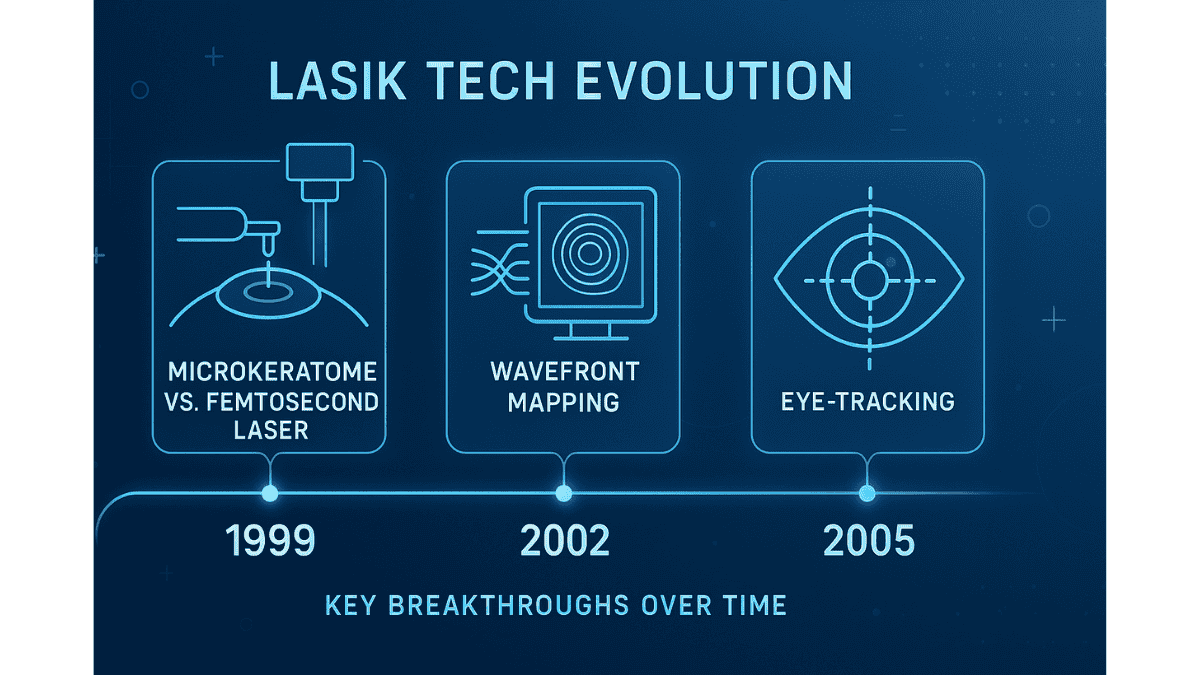
It is important to know that LASIK technology is not static; it has not stayed the same as it was 20 or even 10 years ago. The field has seen remarkable improvements in vision correction procedures. These advancements have played a huge role in enhancing the safety and precision of the procedure, which in turn helps to lower the LASIK complication rate even more and minimize risk.
One major development in advanced LASIK is the use of femtosecond lasers to create the corneal flap. In earlier LASIK procedures, a handheld mechanical blade called a microkeratome was used. Femtosecond lasers allow surgeons to create a thinner, more precise, and more uniform flap with tiny bubbles of gas, which experienced providers find offers greater control.
This generally leads to fewer flap-related complications and faster healing for many patients. Advanced eye-tracking systems are another significant innovation. During the laser treatment part of the LASIK eye surgery, your eye might make tiny, involuntary movements.
Sophisticated eye trackers can follow these movements in real-time. If your eye moves too much, the laser can automatically adjust or pause. This helps make sure the laser treatment is applied exactly where it is intended, which is crucial for good results and minimizing surgery risk.
Custom wavefront technology is also a game-changer for LASIK vision. Just like your fingerprint is distinct, so is the way your eye processes light. Wavefront mapping creates a very detailed 3D map of your eye’s unique imperfections, beyond just nearsightedness, farsightedness, or astigmatism.
This allows for a more personalized laser treatment, aiming to correct these “higher-order aberrations” that can affect vision quality, like night vision or cause subtle vision problems. These technological leaps have significantly improved both the safety profile and the visual outcomes of LASIK surgery. These improvements make the chances of going blind from LASIK extremely remote when performed by experienced providers.
Related Article
How LASIK Eye Surgery WorksComparing LASIK to Other Eye Surgeries
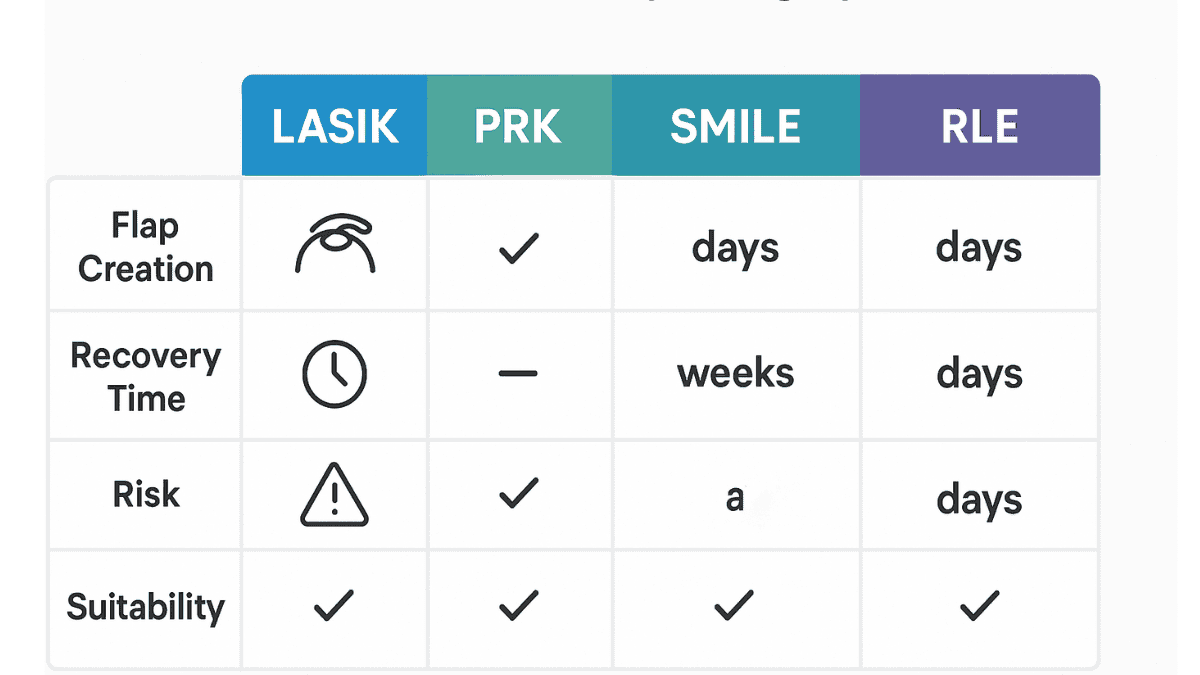
LASIK is a well-known name, but it is not the only type of refractive surgery available to correct vision. There are other vision correction procedures, and sometimes one of these might be a better fit for a particular individual based on their eye health, prescription, or lifestyle. Understanding these alternatives can also provide context to LASIK’s safety and the broader options for correction surgery.
PRK (Photorefractive Keratectomy) is another common laser eye surgery. Unlike LASIK, PRK does not involve creating a corneal flap. Instead, the LASIK surgeon gently removes the cornea’s outer layer (the epithelial cells) and then applies the laser to reshape the cornea. Because there is no flap, flap-related complications, such as issues where epithelial cells grow abnormally, are eliminated.
However, PRK typically has a longer and sometimes more uncomfortable initial recovery period compared to LASIK, often taking a month or more for vision to fully stabilize. It is often recommended for people with thinner corneas or those in professions with a higher risk of eye trauma, as the lack of a flap adds a layer of structural integrity. Experienced providers can guide you on this choice.
SMILE (Small Incision Lenticule Extraction) is a newer laser procedure among the correction procedures available. It is less invasive than LASIK in some ways because it uses a femtosecond laser to create a small, lens-shaped piece of tissue (lenticule) within the cornea. This lenticule is then removed through a tiny incision. This might offer advantages in terms of preserving corneal strength and potentially reducing dry eye issues for some patients, a common concern with any LASIK eye procedure.
You can explore a detailed LASIK vs PRK vs SMILE: Risk Comparison to learn more about the differences and how providers minimize risk with each technique. For individuals with very high prescriptions or those who are older and also dealing with presbyopia (age-related reading vision loss) or cataracts, procedures like Refractive Lens Exchange (RLE) might be considered. RLE is similar to cataract surgery; the eye’s natural lens is replaced with an artificial intraocular lens (IOL). This can correct a wide range of refractive errors and eliminate future cataract development. (Those with high prescriptions can read about LASIK for High Prescriptions specifically to understand potential LASIK limitations and alternatives).
Each of these surgical procedures today has its own specific benefits, risks, and candidacy criteria. Discussing all suitable options with your eye surgeon during the consultation process is the best way to determine which approach is safest and most effective for your unique eyes and vision problems. This discussion should also cover the LASIK cost associated with each option.
Related Article
PRK Surgery: The LASIK AlternativeWhen to Speak to a Doctor About LASIK Fears
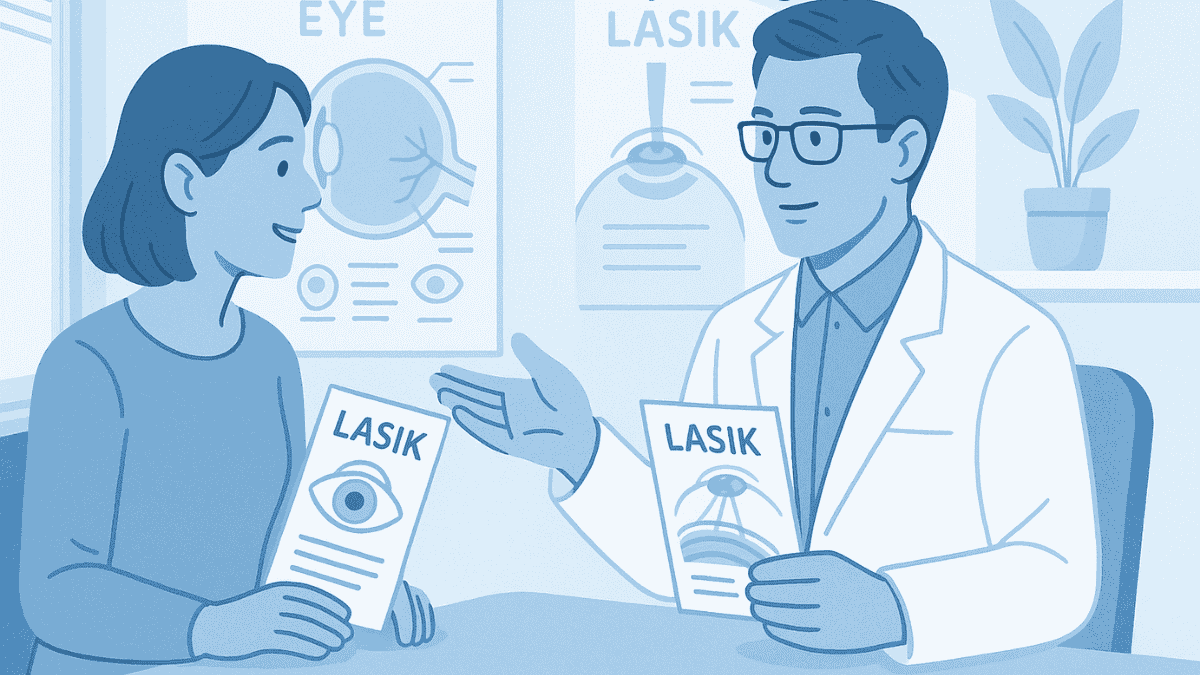
If you are feeling anxious or scared about LASIK surgery, especially about the possibility of serious complications or the fear of blindness, please know that is completely normal and understandable. Your vision is incredibly precious. It is natural to want as much information as possible before making a decision about an eye procedure or any correction surgery.
The very best thing you can do is to schedule a consultation with an experienced and reputable LASIK surgeon or one of the many experienced providers available. This consultation process is your opportunity to ask all your surgeon questions, no matter how basic or detailed they seem. Do not hold back until you feel comfortable and well-informed.
A good doctor will welcome your questions and take the time to explain everything clearly and patiently regarding the potential LASIK procedure. During the consultation, they will thoroughly review your specific eye health and discuss your medical history. They will perform tests to determine if you are a good candidate for this type of vision correction procedures.
They can then discuss your individual surgery risk profile in a realistic way. They should be able to tell you about their own success rates and how they manage potential LASIK complications, helping to minimize risk. Getting personalized information directly from a professional, including details on postoperative care and even LASIK cost, can really help to ease your fears and put them into proper perspective. Reputable clinics will also have a clear privacy policy regarding your medical information. Remember, knowledge and open communication are powerful tools when you are making important healthcare decisions about your LASIK vision.
Conclusion
So, we come back to that pressing question: can you go blind from LASIK? Based on decades of research and millions of successful procedures, the risk of total blindness directly caused by modern, advanced LASIK, when performed on a suitable candidate by a skilled LASIK surgeon, is extraordinarily low. It is so rare that specific statistics for this specific outcome are hard to even quantify because cases of LASIK vision loss leading to total blindness are virtually nonexistent with current standards.
While all surgery carries some level of surgery risk, LASIK is considered one of the safest elective surgical procedures today. The fear of “can you go blind from LASIK,” or the general fear of blindness associated with eye operations, is understandable, but the data offers strong reassurance. These elective surgical procedures today have an excellent safety record when proper protocols are followed by experienced providers.
If you are still worried after reviewing this information about the LASIK eye procedure and its potential LASIK outcomes, please talk to an eye care professional. They can give you the facts relevant to your eyes and help you feel comfortable with your decision regarding vision correction surgery. They can further explain how experienced providers minimize risk to ensure the best possible results.
FAQ
While LASIK carries some risks like any surgery, permanent blindness caused directly by the procedure is extremely rare and almost nonexistent with modern technology.
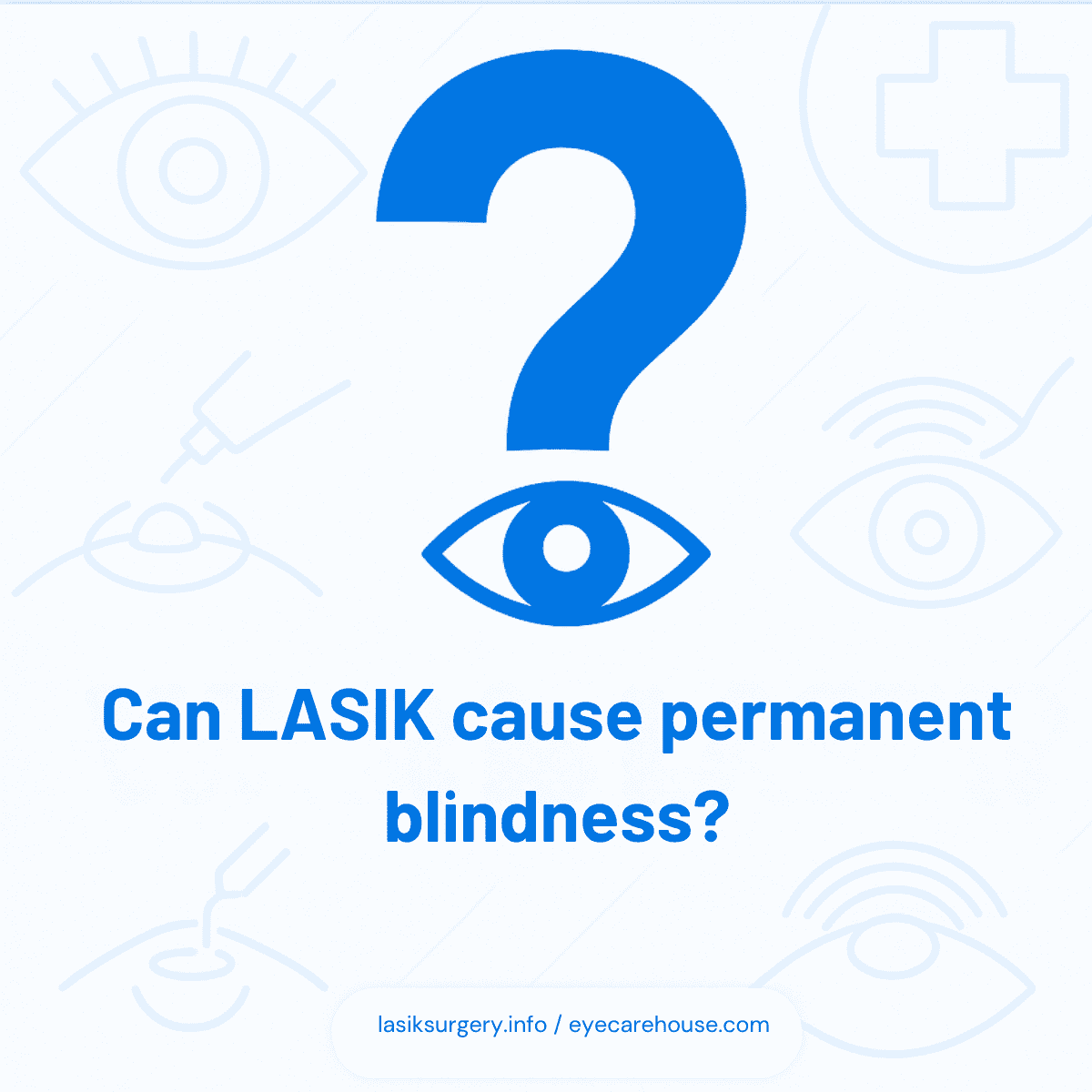
The most common complications include dry eyes, glare, halos, and mild night vision issues—all typically temporary and treatable.
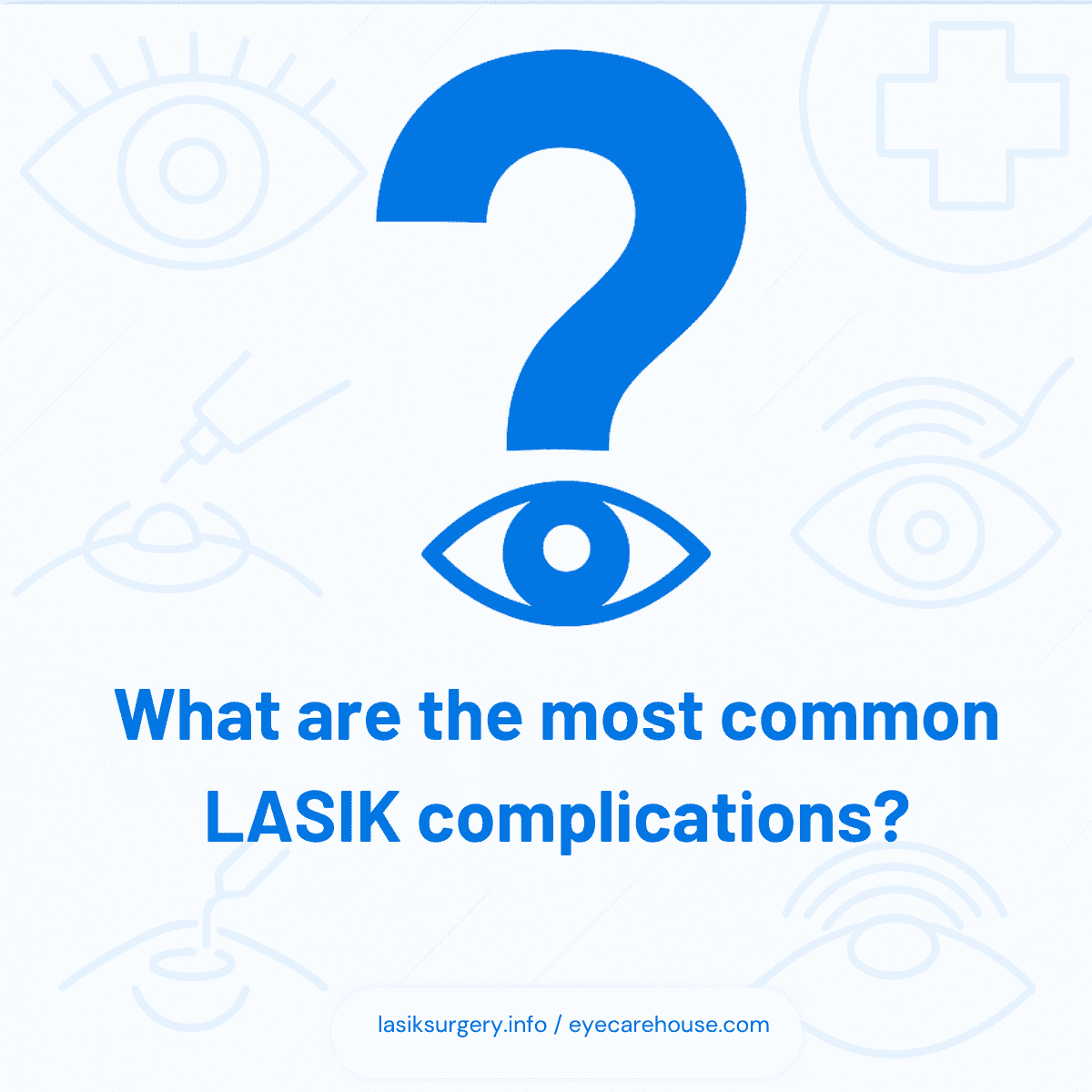
Choosing an experienced surgeon, undergoing a detailed pre-operative screening, and following post-op care instructions reduce risks significantly.
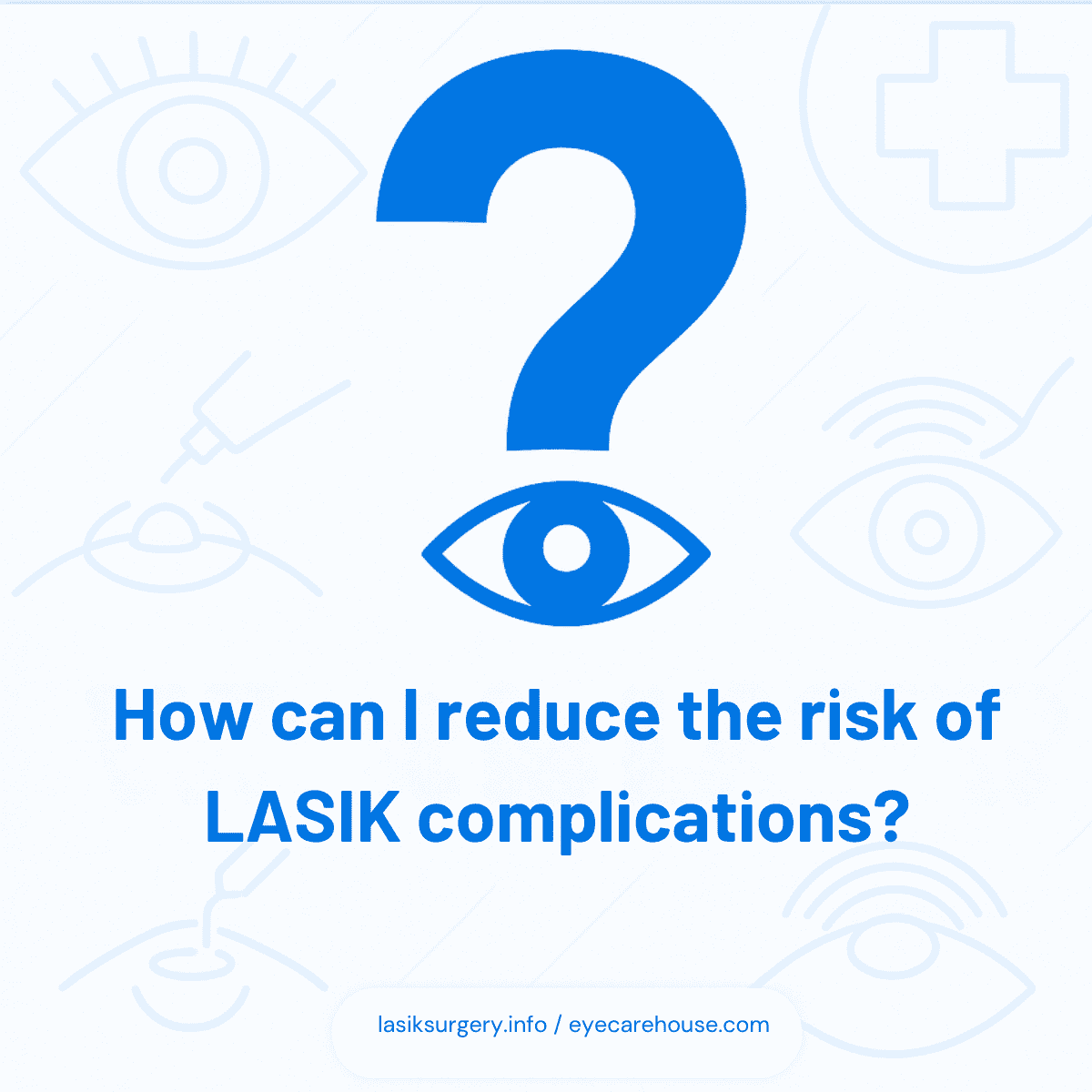
Factors like thin corneas, unstable prescriptions, autoimmune disorders, or severe dry eyes may make LASIK unsuitable.
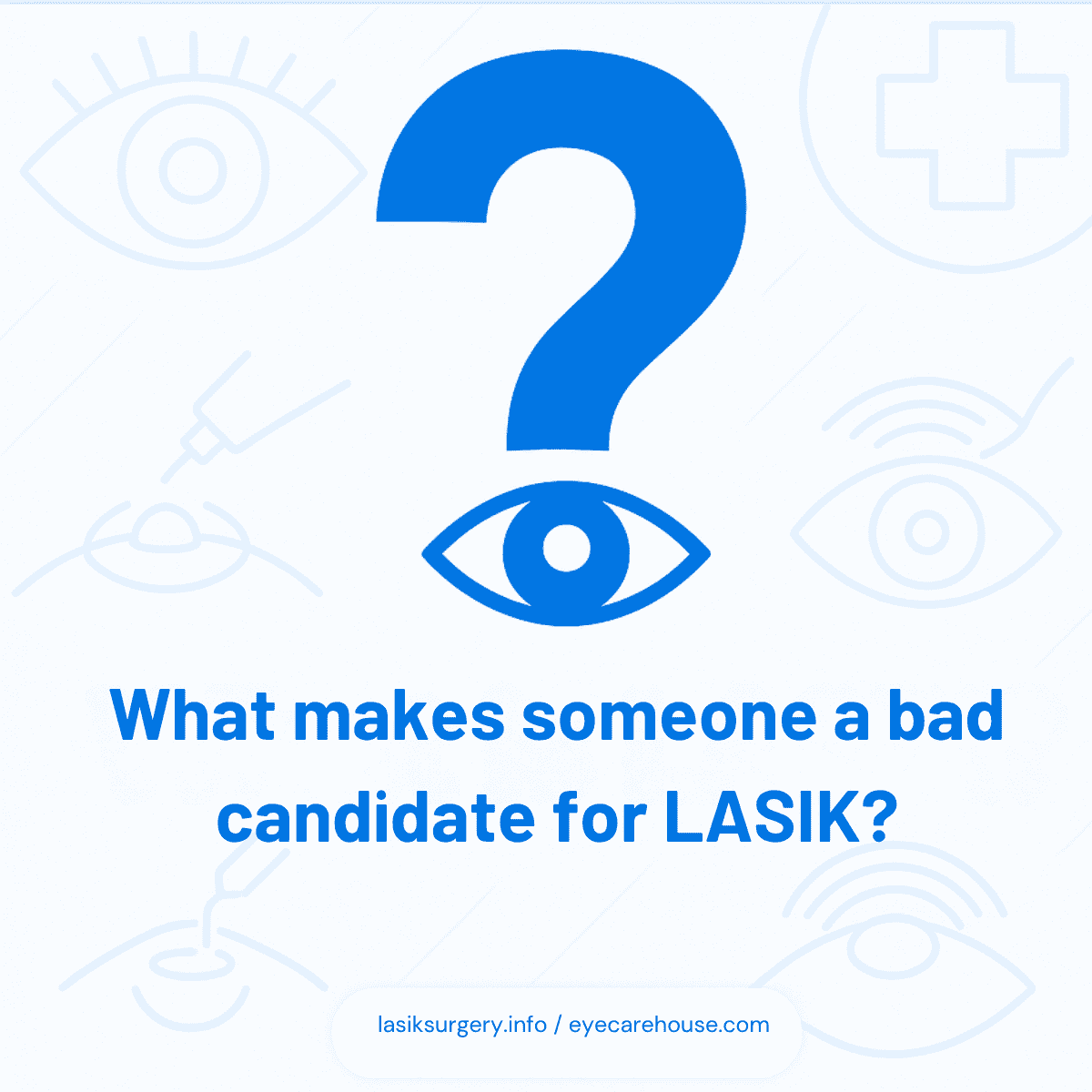
Documented cases of complete blindness directly due to LASIK are nearly nonexistent when performed correctly on a suitable candidate.
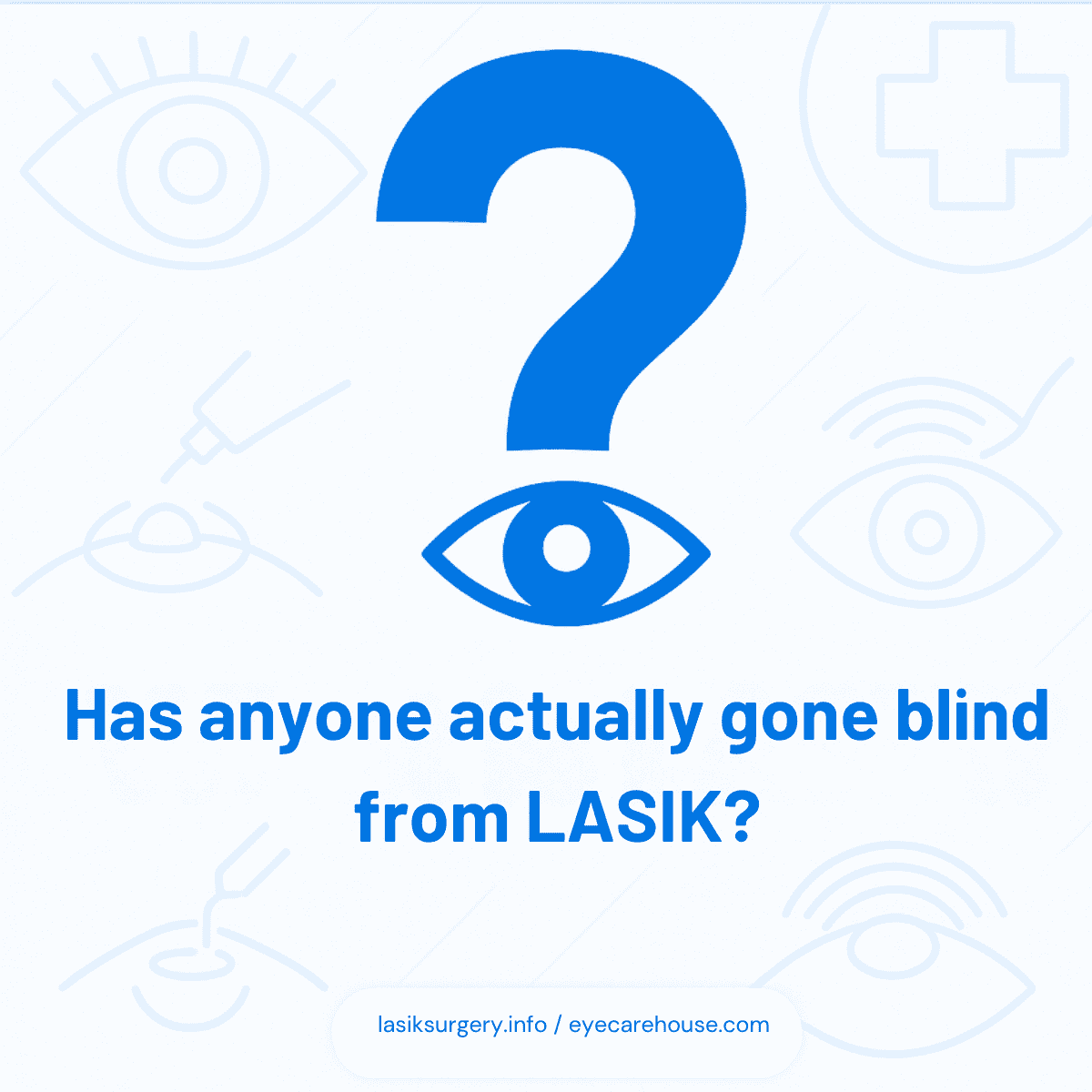
Yes, complication rates have decreased due to advances in laser precision, diagnostic tools, and improved screening protocols.
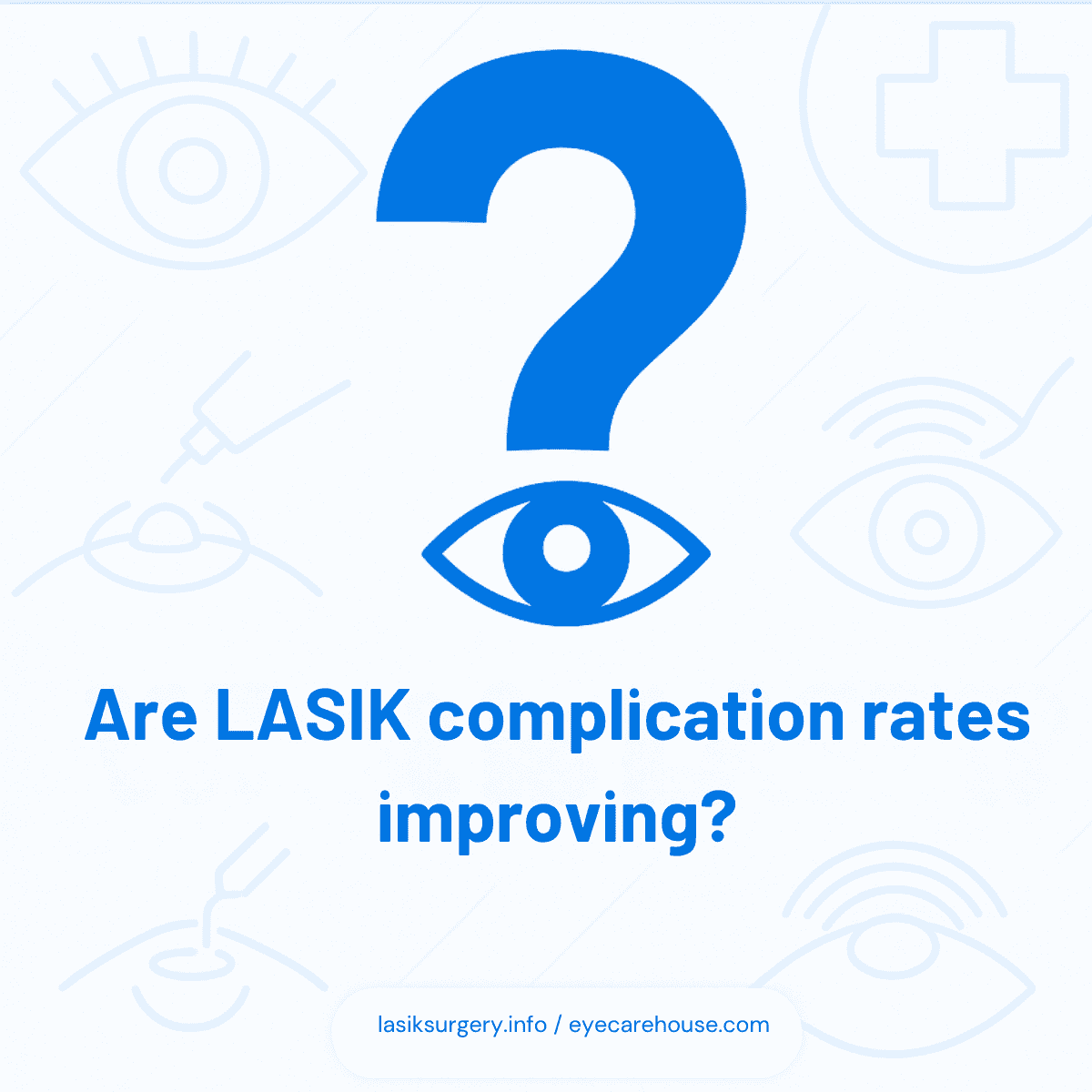
LASIK offers quicker recovery, but PRK and SMILE might be better for specific eye conditions. Each has unique benefits and risks.
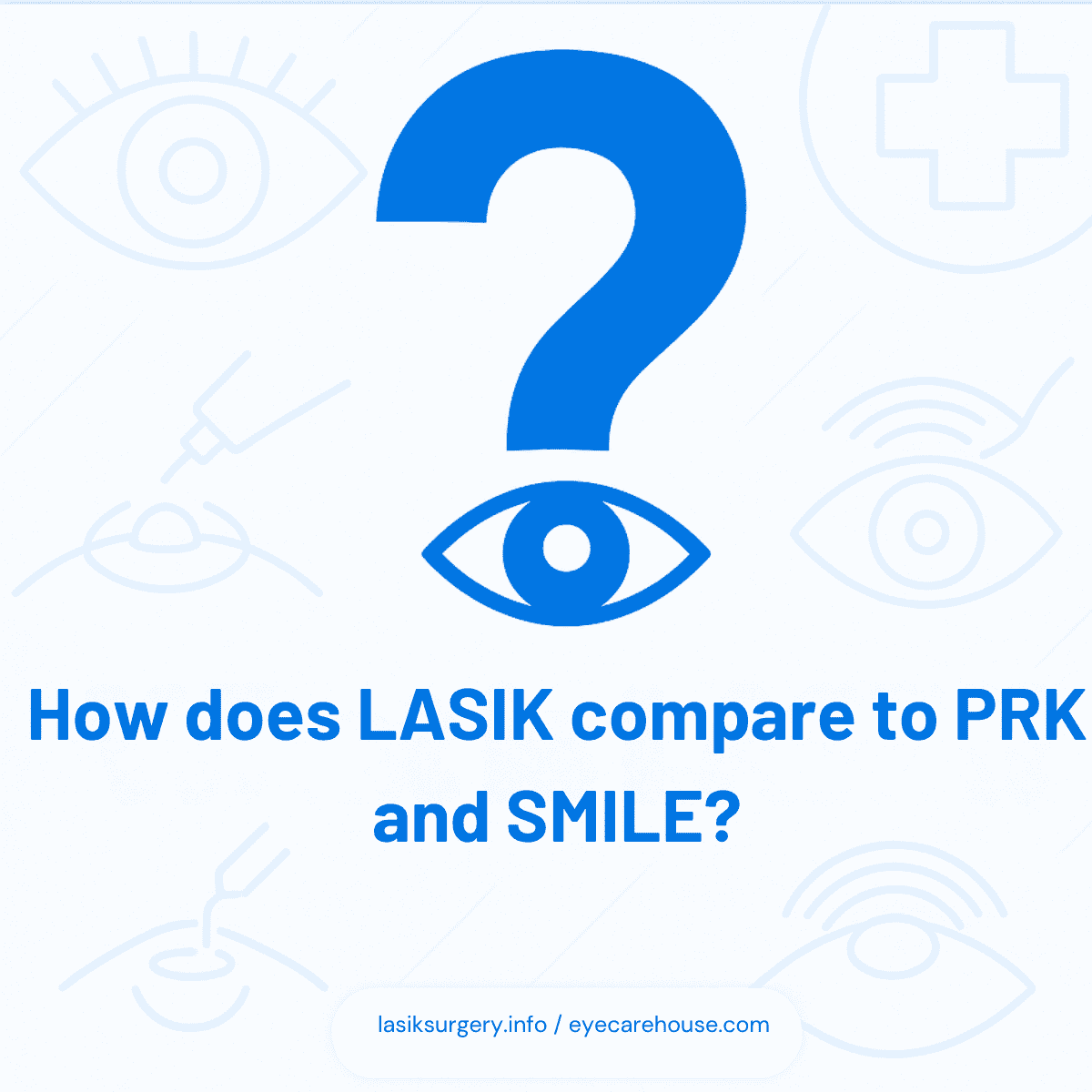
Ask about their experience, complication rates, technology used, and how they handle post-op care and rare risks.
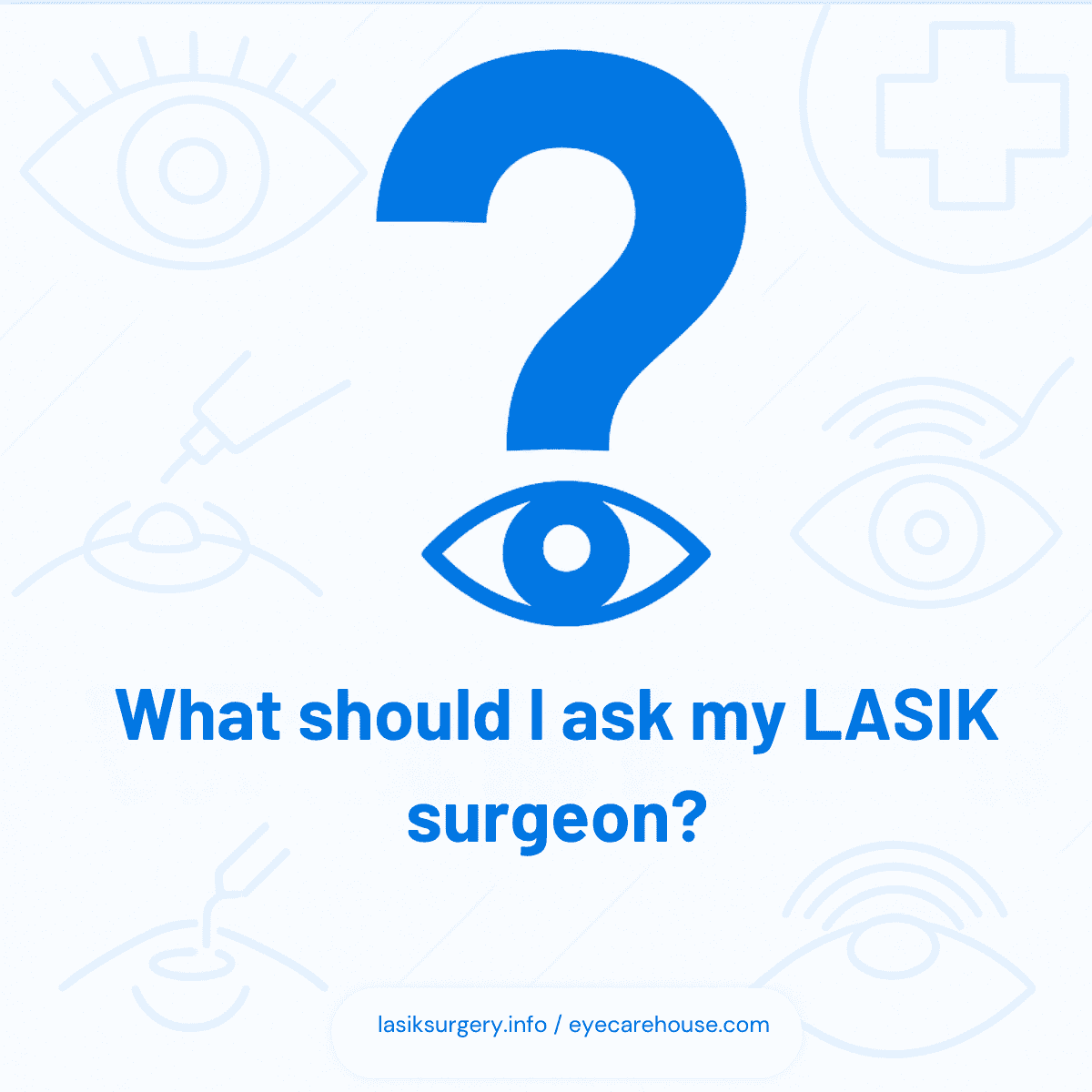
LASIK works best for nearsightedness, farsightedness, and astigmatism. It may not treat presbyopia or advanced conditions.
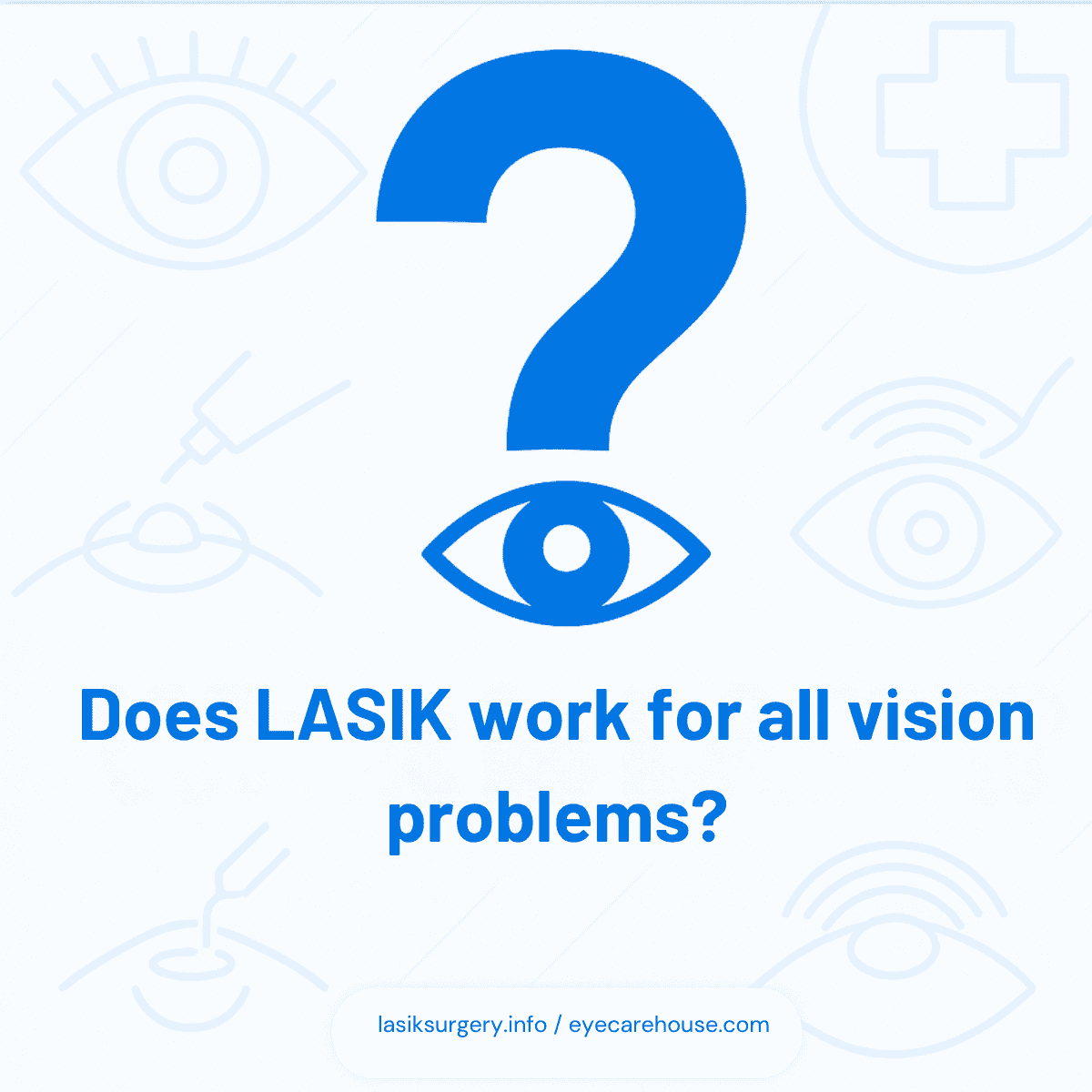
Patients typically have multiple follow-up visits to monitor healing and should use prescribed drops and avoid eye strain.
